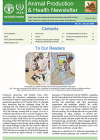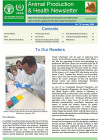Sustainable development in the livestock industry must meet the demands of the world’s growing population for safe and secure food derived from animals reared under increasingly stringent conditions while protecting the environment. We use nuclear techniques to develop sustainable animal production platforms and systems that meet these criteria.
Sustainable animal production
If future food demand is to be met, increased output will have to come mainly from an intensified and more efficient use of the land, water and plant and animal genetic potential, as well as the fisheries and forestry resources that smallholder farmers, particularly in developing countries, have at their disposal. The livestock industry has the challenge of producing sufficient food to satisfy the increasing consumption demands of the growing human population while at the same time reducing total greenhouse gas emissions to protect the environment.
Jointly with the FAO, the IAEA assists Member States in developing and adopting nuclear-based technologies to optimize livestock reproduction and breeding practices that are in line with sustainable development principles, support the intensification of animal production, and optimally utilize the world’s natural resources.
Integrated approaches support sustainability
Integrated, holistic and community-based approaches have been found to support a sustainable increase in animal production. The synergies generated by integrating crop and livestock production systems offer many opportunities for farmers to participate in the sustainable increase in productivity and resource use efficiency. Mixed crop-livestock systems produce about half of the world’s food. In such systems, the output of one process becomes the input of another, and there is minimum nutrient leakage to the environment, for example, in the form of greenhouse gas emissions.
One example for such an integrated approach is how the improvement of feed quality and feed balancing not only lowers enteric and manure greenhouse gas emissions, but also helps increase the farmers’ productivity and income. Another one is how improved breeding and animal health practices help reduce overheads of animals that have been assigned for breeding but, while consuming resources, are not yet producing, which in turn reduces related emissions.
Another example is the silvopastoral system, which combines forestry and grazing of domesticated animals in a mutually beneficial way. Such systems provide advantages over grass-only pasture-livestock production systems by minimizing greenhouse gas emissions and the chemical contamination of soil and waterways, while preserving biodiversity by avoiding the use of vehicles, fertilizers and herbicides.
How nuclear and isotopic techniques can contribute
Radioimmunoassay of hormones using iodine-125 can identify pregnant animals in dairy herds, a technique which can then be applied to reduce the proportion of non-productive animals involved in breeding. Cobalt-60 can be used to construct whole-genome radiation hybrids (RH) panels and RH mapping of livestock species and breeds, and thereby improve animal breeding.
The analysis of carbon-13 in plants eaten by animals and in animals’ faecal samples provides accurate estimates of feed intake by grazing and browsing animals. Stable isotope ratios in metabolically inert tissues from infected birds and animals provide a way of back-tracking their movements, which helps assess the risk of disease dissemination. Gamma irradiation of pathogens makes it possible to develop attenuated vaccines for controlling animal diseases. Finally, the incorporation of tritiated thymidine (3H-TdR) into cellular DNA is used to measure cell proliferation and chromium-51 (51Cr) – an assay that helps monitor vaccine responses.








